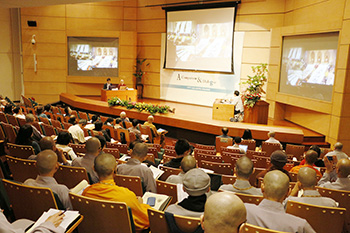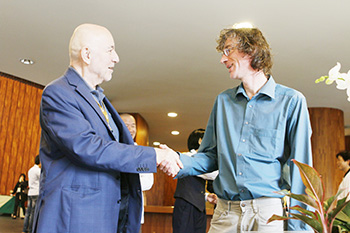“International Conference on Buddhist Meditative Traditions: A Comparison & Dialogue” By Dharma Drum Institute of Libera

The International Conference on Buddhist Meditative Traditions: A Comparison & Dialogue was held on Oct. 25 and 26, 2014 to explain different aspects of Buddhist Meditation to the public. This conference was organizes by the Dharma Drum Institute of Liberal Arts (DILA) and scholars from different countries were invited to present their views on this subject. Amongst those present were Bhikkhu Anālayo from the University of Hamburg in Germany, Bart Dessein from Ghent University in Belgium and Sāmaṇerī Dhammadinnā from DILA, just to name a few.
Ven. Hui Min, president of DILA, explained that DILA was founded with “Protection of Spiritual Environment” as its core value and “Liberal Arts Education” as its school policy in the opening speech. Therefore, in line with its founding principles, DILA will start recruiting students for its M.A. Degree program in Life Education, Community Regeneration, Social Enterprise and Innovation as well as Environment and Development in the spring of 2015. These graduate programs together with programs offered by the Department of Buddhist Studies are designed to provide interdisciplinary literacy training through the construction and integration of independent learning environment. Ultimately, these programs are expected to produce graduates who are better equipped to contribute to society and care for the environment.

The topics of discussion for this conference ranged from “Agama” of early Buddhism as well as theories of Mahayana Buddhism and early Buddhist schools to teachings and writing of early modern Chan masters. In addition, similarities and differences between Buddhist Meditation, other religious meditation as well as the science of meditation were also discussed.
Presenting his paper on “How Chinese Chan Buddhism Evolved from the Vipassana of Theravada Buddhism?” on the morning of Oct. 25, Wen, Tsung-Kun explained the differences in the concepts and thoughts between Theravada Buddhism and Chan Buddhism, e.g., the Tathāgatagarbha thought versus the Buddha-nature. However, there are instances where these variations are due to languages differences. Moreover, upon reflection, it is easy to identify similarities in these two traditions, particularly in methods of practice. On Oct. 26, Professor Giovanni Verardi of Università L’Orientale of Naples, Italy delivered a keynote speech on the relationship between meditation, rituals and history in India, presenting the diversity of meditation theories and practice methods.

Besides scholars, the general public found the conference presentations beneficial as well. For example, Ms. Huang, an experienced meditator who is very interested in “Pressure Relaxation by Right Mindfulness” and Chan meditation, indicated that she has a much deeper understanding of Chan meditation after attending the conference.
(Translated by Tom Hsieh/Edited by Leefah)